Water and Energy Balance Model GOES-PRWEB: Development and Validation
Abstract
:1. Introduction
2. Materials and Methods
2.1. Energy Balance
2.2. Water Balance
2.3. Reference Evapotranspiration
2.4. GOES-PRWEB Products and Data
2.5. Study Area
2.6. Evaluation of ETo and Other Weather Parameters
2.7. Evaluation of Soil Moisture Estimates
2.8. Island-Scale Comparisons
- Annual ETa from GOES-PRWEB and the SSEBop model were compared for 2009–2020;
- Annual values of the water balance components from GOES-PRWEB and the USGS ([62]) were compared for 2009–2020.
2.9. Basin-Scale Comparisons
- Comparisons of cumulative monthly streamflow were made for GOES-PRWEB and the US Geological Survey (USGS) stream gage located at the outlet of the Guanajibo watershed in southwest Puerto Rico for the years 2010, 2011, and 2012. Total streamflow was assumed to be the combined flow from surface runoff and deep percolation, where the latter contributes to the stream base flow. Since the model does not explicitly account for groundwater storage, this may be a source of error during short periods. However, over more extended periods, such as a year and during hydrologically normal years, the change in storage was small.
- GOES-PRWEB and USGS-based annual ETa estimates were compared for the Guanajibo watershed for 2009–2020. The USGS-based ETa was estimated as P − (RO + DP), where (RO + DP) is considered to be equal to the total measured streamflow.
2.10. Pixel Scale Comparison
2.11. Water Balance Error Analyses
3. Results
3.1. Evaluation of ETo and Other Weather Parameters
3.2. Evaluation of Soil Moisture Estimation
3.3. Basin-Scale Streamflow Comparison
3.4. Basin-Scale Actual Evapotranspiration Comparison
3.5. Actual Evapotranspiration Evaluation
3.5.1. Island-Wide ETa Evaluation
3.5.2. ETa Evaluation at Three Locations
3.6. Island-Wide Water Balance Component Comparison
3.7. Water Balance Error Analyses
3.7.1. Pixel-Scale Water Balance Error Analyses
3.7.2. Island-Wide Water Balance Error Analysis
4. Discussion and Conclusions
4.1. Model Applications
4.2. Discussion of Selected Validation Results
4.3. Some Model Limitations
- The model ETo and water and energy balance results are based on weather data (Ta, Td, u2) obtained from NDFD or CARICOOS WRF model, Rs from the GOES satellite algorithm, and rainfall from NOAA’s AHPS. The main advantage of deriving the input data from these sources is that it is gridded data and is readily assimilated into the model, unlike weather station data which requires interpolation of weather variables. The disadvantage of the gridded data is that it is produced from models and is subject to errors. Furthermore, these data sources are not always available. For example, during Hurricane María, the Doppler Radar (NEXRAD) in Cayey, Puerto Rico, was severely damaged and was not available for nine months.
- All water that infiltrates into the soil that exceeds the field capacity becomes DP. This is based on the concept of a "field capacity" and that all water in excess of the field capacity moisture content will percolate past the root zone. The field capacity concept simplifies the soil profile, assuming homogeneous texture and that all of the soil water between the total porosity and field capacity drains within 24 h. Although this may introduce potential errors, as mentioned above (not to mention that an incorrect value of the field capacity could be used), the encouraging results obtained in this study suggest that using the field capacity concept is functionally valid.
- Throughout its 12-year life, the model has undergone periodic modifications, ranging from improvements to specific algorithms, changes in input data sources, and adjustment of parameters. Ideally, the model should be reevaluated for ETa, soil moisture, and streamflow after any modifications; however, this is difficult to achieve in practice.
- The 1-km spatial resolution of the model does not permit estimation for farm-scale conditions. Nevertheless, as shown in [64], the model can be used for specific applications, such as irrigation scheduling, if site-specific information is available.
- The model is limited to a 1-day time step and, therefore, precludes applications requiring hourly or shorter time steps.
- Daily results should be used with caution. Although daily data are available for use, results for longer time periods will tend to be more accurate because the negative and positive daily errors tend to cancel each other out.
- In its current form, the model is not capable of estimating snowmelt, which would be required for use at locations in the upper latitudes.
4.4. Advantages of GOES-PRWEB
Author Contributions
Funding
Institutional Review Board Statement
Informed Consent Statement
Data Availability Statement
Acknowledgments
Conflicts of Interest
Appendix A. Comparison of Selected Model Input Variables with Observed Data
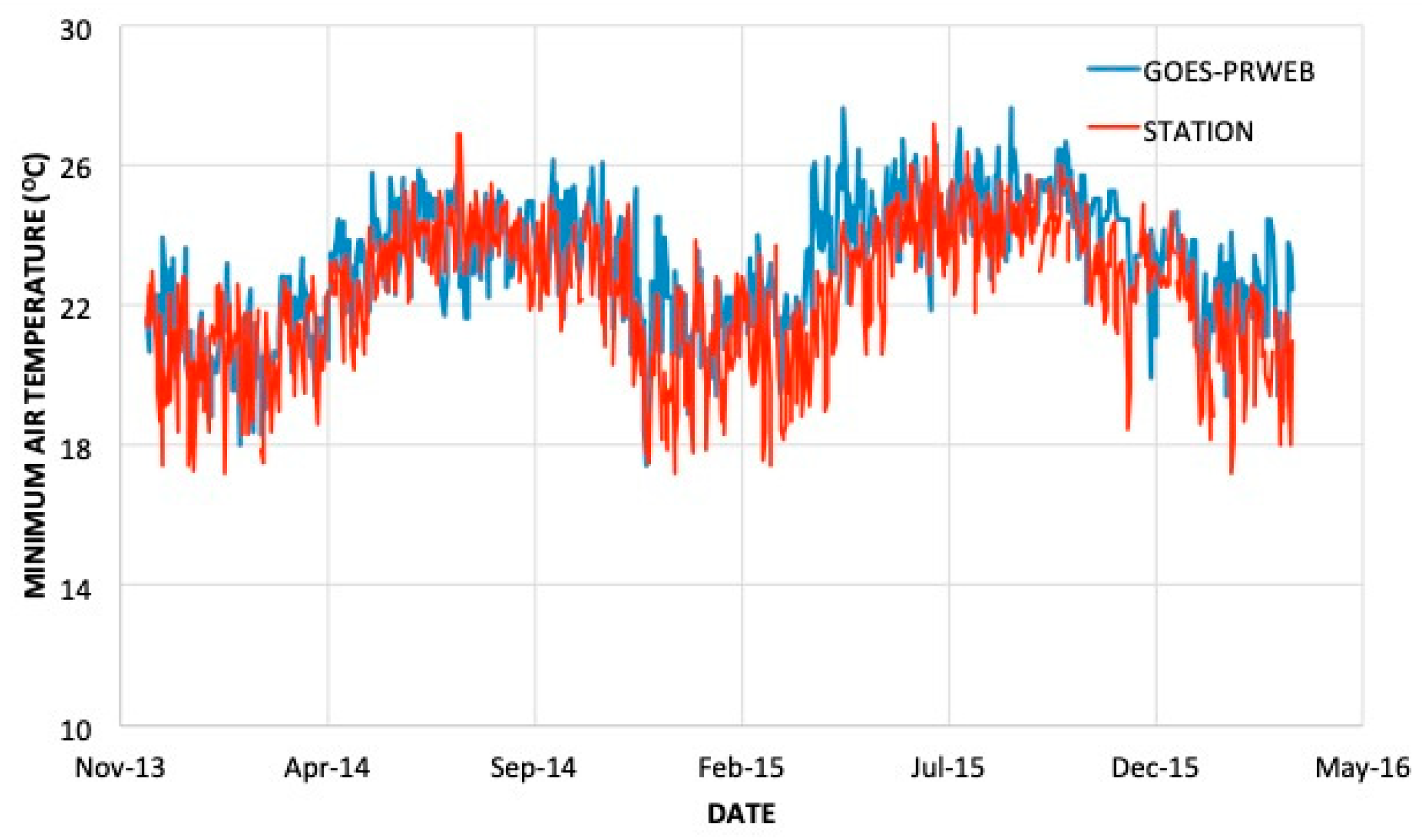
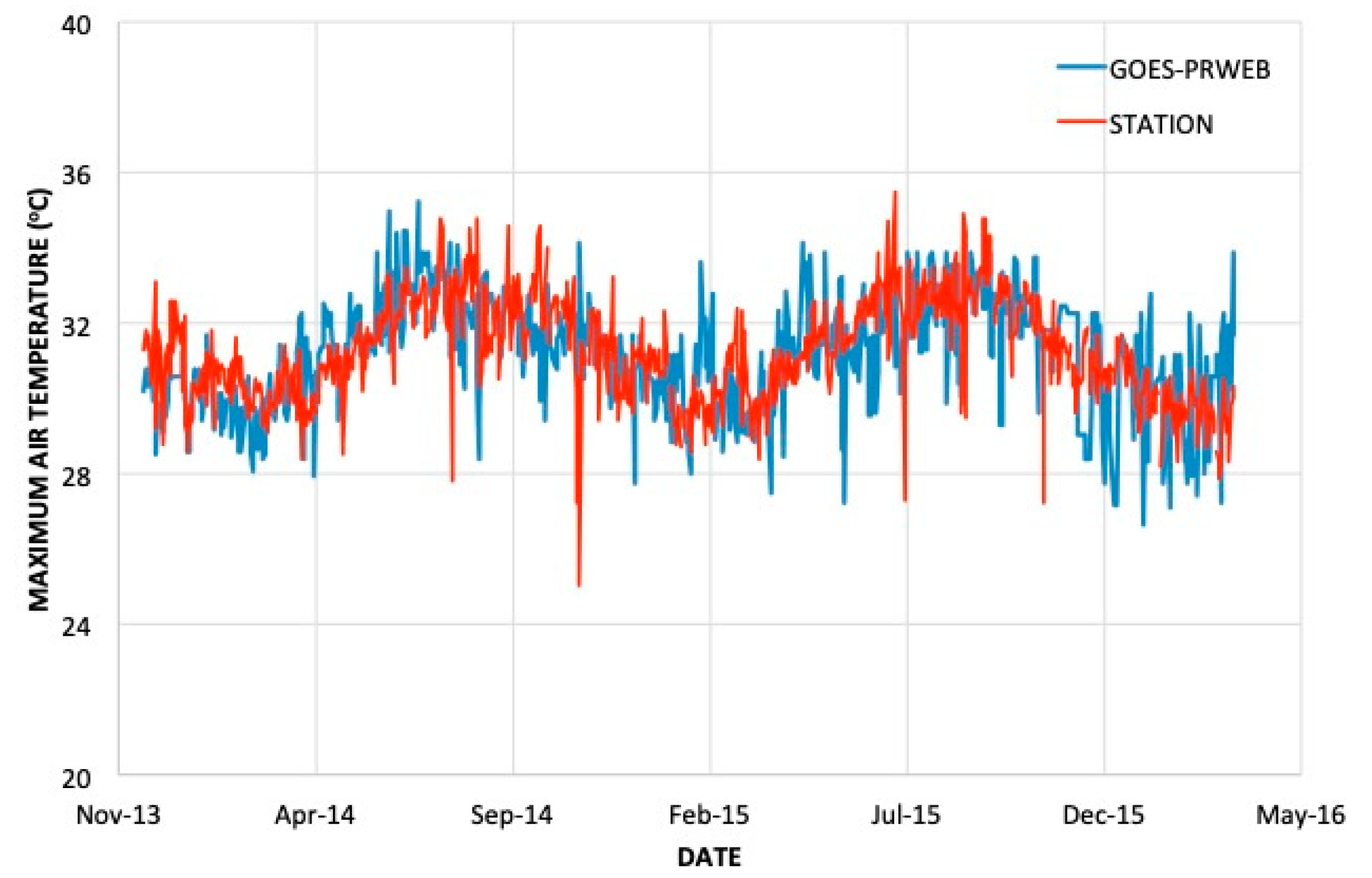
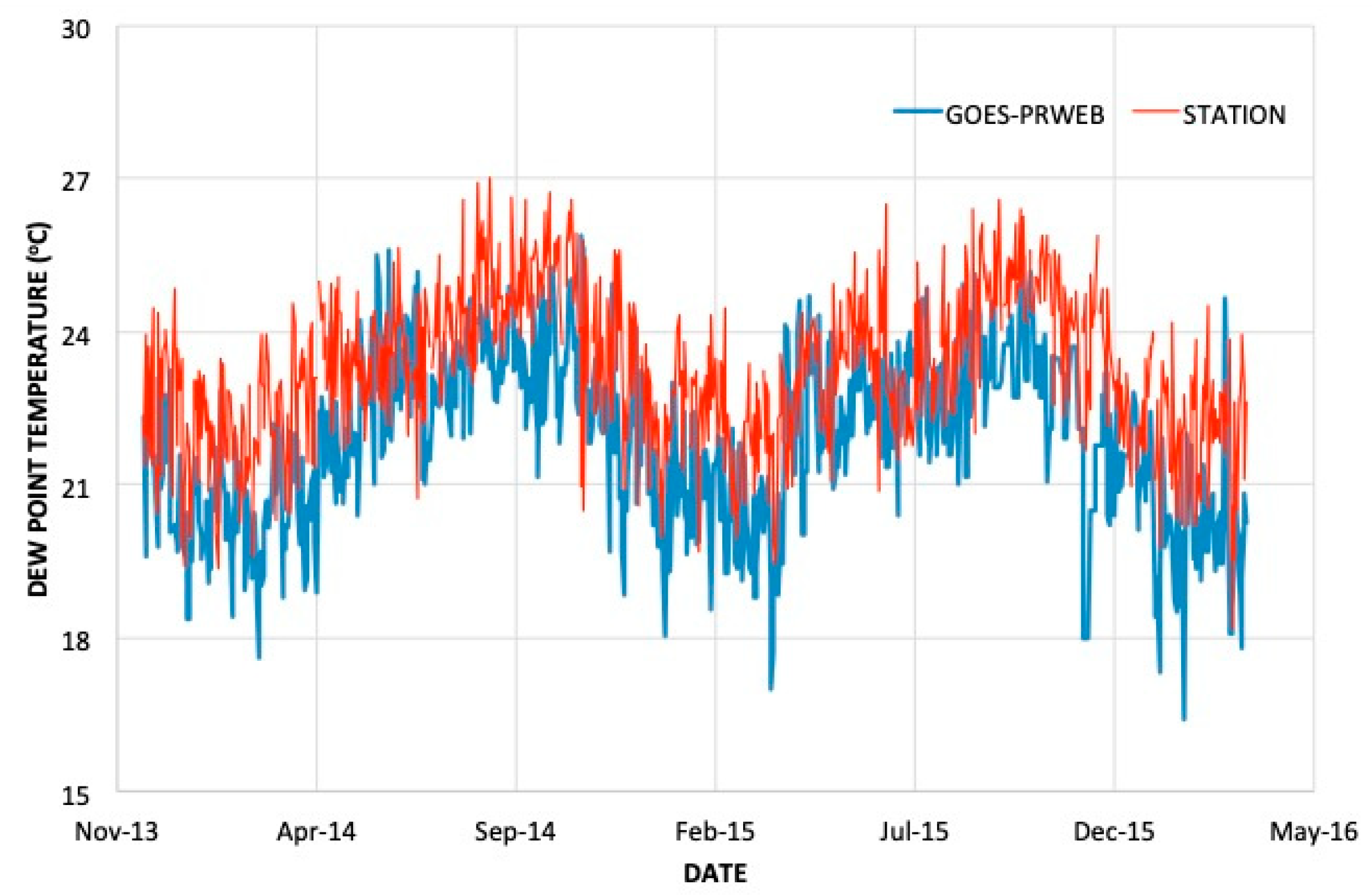
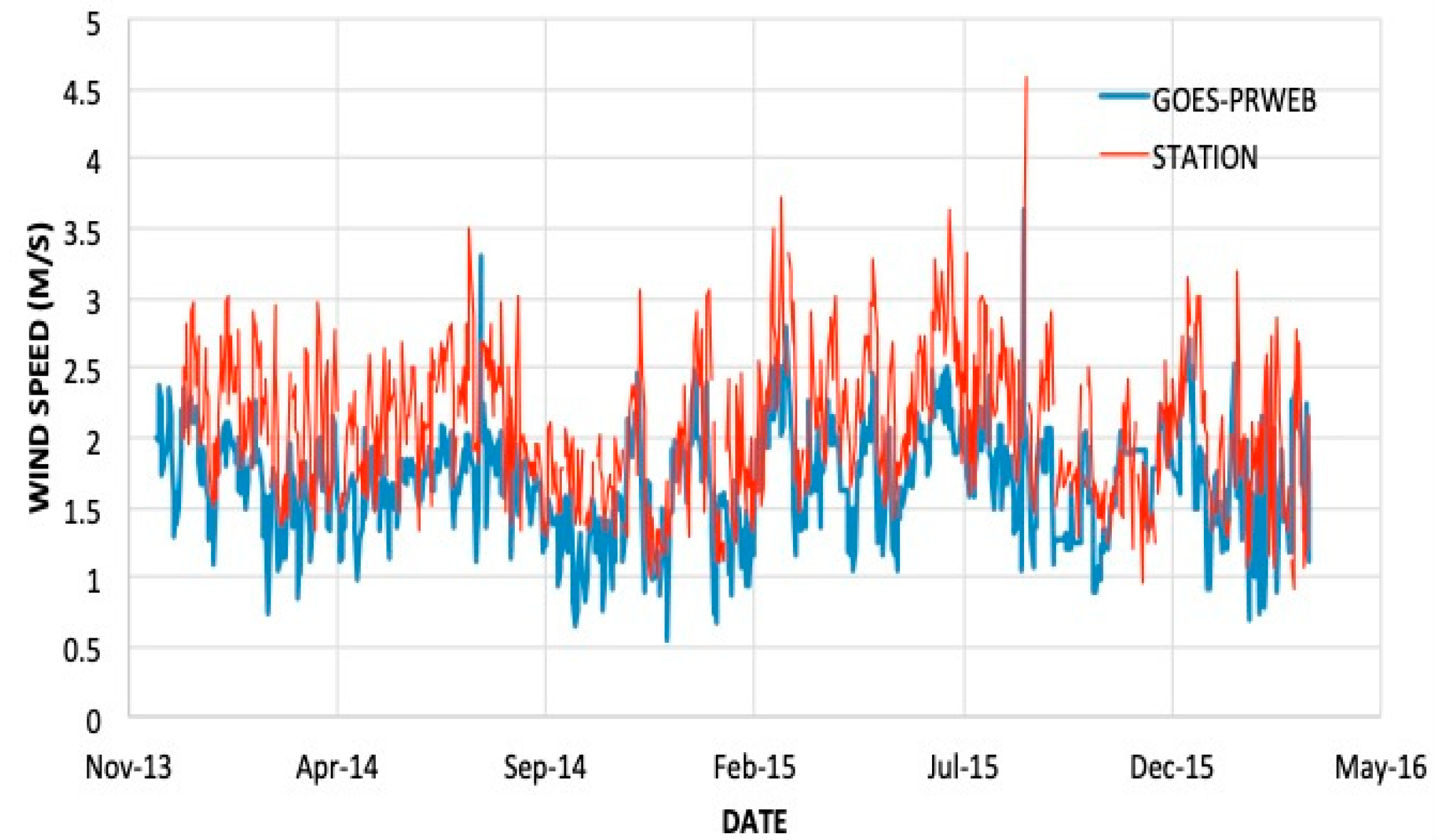

Appendix B
| Year | Daily Mean Error (mm) | Std Dev. (mm) | Minimum Error (mm) | Maximum Error (mm) |
|---|---|---|---|---|
| 2009 | −0.07 | 2.13 | −3.06 | 14.91 |
| 2010 | −0.06 | 2.00 | −2.22 | 13.20 |
| 2011 | 0.02 | 2.26 | −2.21 | 10.37 |
| 2012 | 0.05 | 2.45 | −2.03 | 16.88 |
| 2013 | 0.02 | 2.11 | −2.25 | 8.03 |
| 2014 | −0.01 | 2.42 | −2.01 | 13.83 |
| 2015 | 0.01 | 2.42 | −1.96 | 13.87 |
| 2016 | 0.01 | 2.28 | −2.40 | 11.31 |
| 2017 | −0.02 | 2.54 | −2.25 | 13.02 |
| 2018 | −0.05 | 2.06 | −1.85 | 8.18 |
| 2019 | 0.06 | 2.23 | −1.84 | 14.24 |
| 2020 | −0.02 | 2.19 | −2.04 | 12.44 |
| Annual Mean Error | 0.00 | 2.26 | −2.18 | 12.52 |
| Std. Dev. | 0.04 | 0.17 | 0.33 | 2.65 |
| Year | Daily Mean Error (mm) | Std Dev. (mm) | Minimum Error (mm) | Maximum Error (mm) |
|---|---|---|---|---|
| 2009 | 0.01 | 3.42 | −1.87 | 33.16 |
| 2010 | 0.04 | 3.19 | −2.54 | 22.69 |
| 2011 | 0.01 | 3.38 | −2.39 | 24.11 |
| 2012 | −0.02 | 3.29 | −2.24 | 22.20 |
| 2013 | 0.07 | 3.00 | −1.97 | 26.69 |
| 2014 | −0.02 | 3.22 | −2.31 | 38.00 |
| 2015 | −0.10 | 1.61 | −1.57 | 11.11 |
| 2016 | 0.10 | 3.02 | −1.95 | 22.45 |
| 2017 | −0.04 | 2.62 | −2.17 | 23.58 |
| 2018 | −0.10 | 1.68 | −1.41 | 13.87 |
| 2019 | 0.10 | 2.32 | −1.79 | 27.55 |
| 2020 | 0.04 | 3.12 | −1.95 | 27.91 |
| Annual Mean Error | 0.01 | 2.82 | −2.01 | 24.44 |
| Std. Dev. | 0.07 | 0.63 | 0.33 | 7.32 |
| Year | Daily Mean Error (mm) | Std Dev. (mm) | Minimum Error (mm) | Maximum Error (mm) |
|---|---|---|---|---|
| 2009 | −0.04 | 1.86 | −2.93 | 11.82 |
| 2010 | −0.02 | 1.88 | −2.47 | 17.29 |
| 2011 | −0.01 | 1.72 | −1.65 | 12.44 |
| 2012 | 0.03 | 1.95 | −1.63 | 15.47 |
| 2013 | 0.02 | 1.99 | −1.94 | 13.78 |
| 2014 | −0.02 | 2.42 | −2.20 | 25.28 |
| 2015 | −0.02 | 1.86 | −1.79 | 10.66 |
| 2016 | 0.04 | 1.81 | −2.72 | 9.64 |
| 2017 | −0.08 | 1.96 | −2.39 | 13.80 |
| 2018 | −0.01 | 1.68 | −2.04 | 9.41 |
| 2019 | 0.08 | 2.10 | −2.67 | 13.18 |
| 2020 | −0.02 | 2.21 | −2.39 | 18.15 |
| Annual Mean Error | 0.00 | 1.95 | −2.23 | 14.24 |
| Std. Dev. | 0.04 | 0.21 | 0.43 | 4.43 |
References
- Healy, R.; Winter, T.C.; LaBaugh, J.W.; Franke, O.L. Water Budgets: Foundations for Effective Water-Resources and Environmental Management Circular 1308; USGS: Reston, VA, USA, 2007. [Google Scholar]
- Tweed, S.O.; Leblanc, M.; Webb, J.; Lubczynski, M.W. Remote sensing and GIS for mapping groundwater recharge and discharge areas in salinity prone catchments, southeastern Australia. Hydrogeol. J. 2006, 15, 75–96. [Google Scholar] [CrossRef]
- Boruff, B.; Cutter, S. The Environmental Vulnerability of Caribbean Island Nations. Geogr. Rev. 2007, 97, 24–45. [Google Scholar] [CrossRef]
- Gould, W.A.; Diaz, E.L.; Álvarez-Berríos, N.L.; Aponte-González, F.; Archibald, W.; Bowden, J.H.; Carrubba, L.; Crespo, W.; Fain, S.J.; González, G.; et al. US Caribbean, in Impacts, Risks and Adaptation in the United States: 4th National Climate Assessment; Reidmiller, D., Avery, C.W., Easterling, D.R., Kunkel, K.E., Lewis, K.L.M., Maycock, T.K., Stewart, B.C., Eds.; US Global Change Research Program: Washington, DC, USA, 2018; Volume 2, pp. 809–871. [Google Scholar] [CrossRef]
- Unfccc. Vulnerability and Adaptation to Climate Change in Small Island Developing States. Available online: https://unfccc.int/files/adaptation/adverse_effects_and_response_measures_art_48/application/pdf/200702_sids_adaptation_bg.pdf (accessed on 22 July 2021).
- Hobbins, M.T.; Dai, A.; Roderick, M.L.; Farquhar, G. Revisiting the parameterization of potential evaporation as a driver of long-term water balance trends. Geophys. Res. Lett. 2008, 35. [Google Scholar] [CrossRef] [Green Version]
- Zeleke, K.T.; Wade, L.J. Evapotranspiration Estimation Using Soil Water Balance, Weather and Crop Data. In Evapotranspiration: Remote Sensing and Modeling; Irmak, I., Ed.; InTech Open Limited: London, UK, 2012; ISBN 978-953-307-808-3. Available online: http://www.intechopen.com/books/evapotranspiration-remote-sensing-and-modeling/evapotranspiration-estimation-using-soil-water-balance-weather-and-crop-data (accessed on 15 June 2021).
- Karpouzos, D.K.; Baltas, E.A.; Kavalieratou, S.; Babajimopoulos, C. A hydrological investigation using a lumped water balance model: The Aison River Basin case (Greece). Water Environ. J. 2010, 25, 297–307. [Google Scholar] [CrossRef]
- Gemitzi, A.; Ajami, H.; Richnow, H. Developing empirical monthly groundwater recharge equations based on modeling and remote sensing data—Modeling future groundwater recharge to predict potential climate change impacts. J. Hydrol. 2017, 546, 1–13. [Google Scholar] [CrossRef]
- Falalakis, G.; Gemitzi, A. A simple method for water balance estimation based on the empirical method and remotely sensed evapotranspiration estimates. J. Hydroinform. 2020, 22, 440–451. [Google Scholar] [CrossRef]
- Dalezios, N.R.; Dercas, N.; Blanta, A.; Faraslis, I.N. Remote sensing in water balance modelling for evapotranspiration at a rural watershed in Central Greece. Int. J. Sustain. Agric. Manag. Inform. 2018, 4, 306. [Google Scholar] [CrossRef]
- Latha, J.C.; Saravanan, S.; Palanichamy, K. A Semi-Distributed Water Balance Model for Amaravathi River Basin using Remote Sensing and GIS. Int. J. Geomat. Geosci. 2010, 1, 252–263. [Google Scholar]
- Castiglioni, S.; Lombardi, L.; Toth, E.; Castellarin, A.; Montanari, A. Calibration of rainfall-runoff models in ungauged basins: A regional maximum likelihood approach. Adv. Water Resour. 2010, 33, 1235–1242. [Google Scholar] [CrossRef]
- Guo, J.; Guo, S.; Li, T. Daily runoff simulation in Poyang Lake Intervening Basin based on remote sensing data. Procedia Environ. Sci. 2011, 10, 2740–2747. [Google Scholar] [CrossRef]
- Li, Y.; Zhang, Q.; Yao, J.; Werner, A.D.; Li, X. Hydrodynamic and Hydrological Modeling of the Poyang Lake Catchment System in China. J. Hydrol. Eng. 2014, 19, 607–616. [Google Scholar] [CrossRef]
- Lu, J.; Chen, X.; Zhang, L.; Sauvage, S.; Sánchez-Pérez, J.-M. Water balance assessment of an ungauged area in Poyang Lake watershed using a spatially distributed runoff coefficient model. J. Hydroinform. 2018, 20, 1009–1024. [Google Scholar] [CrossRef]
- Leopoldo, P.R.; Franken, W.K.; Nova, N.A.V. Real evapotranspiration and transpiration through a tropical rain forest in central Amazonia as estimated by the water balance method. For. Ecol. Manag. 1995, 73, 185–195. [Google Scholar] [CrossRef]
- Mohammed, I.N.; Bolten, J.D.; Srinivasan, R.; Lakshmi, V. Improved Hydrological Decision Support System for the Lower Mekong River Basin Using Satellite-Based Earth Observations. Remote. Sens. 2018, 10, 885. [Google Scholar] [CrossRef] [Green Version]
- Zhang, L.; Sun, G.; Cohen, E.; McNulty, S.G.; Caldwell, P.V.; Krieger, S.; Christian, J.; Zhou, D.; Duan, K.; Cepero-Pérez, K.J. An Improved Water Budget for the El Yunque National Forest, Puerto Rico, as Determined by the Water Supply Stress Index Model. For. Sci. 2018, 64, 268–279. [Google Scholar] [CrossRef] [Green Version]
- Mecikalski, J.R.; Harmsen, E.W. The Use of Visible Geostationary Operational Meteorological Satellite Imagery in Mapping the Water Balance over Puerto Rico for Water Resource Management. In Satellite Information Classification and Interpretation; IntechOpen Limited: London, UK, 2019; Available online: https://www.intechopen.com/chapters/64916 (accessed on 1 May 2021). [CrossRef] [Green Version]
- Harmsen, W.E.; Trinidad, J.C.; Arcelay, C.L.; Rodríguez, D.C. Evaluation of percolation and nitrogen leaching from a sweet pepper crop grown on an oxisol soil in Northwest Puerto Rico. In Proceedings of the Thirty-Ninth Anuual Meeting of the Caribbean Food Crop Society, St. George’s, Grenada, 13–18 July 2003; Volume 39. [Google Scholar]
- Paulino-Paulino, J.P.; Harmsen, E.W.; Sotomayor, D.; Rivera, L.E. Nitrate leaching under different levels of irri-gation for three turfgrasses in southern Puerto Rico. Univ. Puerto Rico J. Agric. 2008, 92, 135–152. [Google Scholar] [CrossRef]
- Harmsen, E.W.; Miller, N.L.; Schlegel, N.J.; González, J. Seasonal climate change impacts on evapotranspiration, precipitation deficit and crop yield in Puerto Rico. Agric. Water Manag. 2009, 96, 1085–1095. [Google Scholar] [CrossRef]
- Sumner, D.M.; Pathak, C.S.; Mecikalski, J.R.; Paech, S.J.; Wu, Q.; Sangoyomi, T. Calibration of GOES-Derived Solar Radiation Data Using a Distributed Network of Surface Measurements in Florida, USA. In Proceedings of the World Environmental and Water Resources Congress 2008, Honolulu, HI, USA, 12–15 May 2008; pp. 1–10. [Google Scholar] [CrossRef]
- Harmsen, E.W.; Cruz, P.T.; Mecikalski, J.R. Calibration of selected pyranometers and satellite derived solar radiation in Puerto Rico. Int. J. Renew. Energy Technol. 2014, 5, 43. [Google Scholar] [CrossRef] [Green Version]
- Diak, G.R. Investigations of improvements to an operational GOES-satellite-data-based insolation system using pyranometer data from the U.S. Climate Reference Network (USCRN). Remote. Sens. Environ. 2017, 195, 79–95. [Google Scholar] [CrossRef]
- Mecikalski, J.R.; Shoemaker, W.B.; Wu, Q.; Holmes, M.A.; Paech, S.J.; Sumner, D.M. High-Resolution GOES Insolation–Evapotranspiration Data Set for Water Resource Management in Florida: 1995–2015. J. Irrig. Drain. Eng. 2018, 144, 04018025. [Google Scholar] [CrossRef]
- Peng, J.; Loew, A.; Chen, X.; Ma, Y.; Su, Z. Comparison of satellite-based evapotranspiration estimates over the Tibetan Plateau. Hydrol. Earth Syst. Sci. 2016, 20, 3167–3182. [Google Scholar] [CrossRef] [Green Version]
- Krajewski, W.F.; Anderson, M.C.; Eichinger, W.E.; Entekhabi, D.; Hornbuckle, B.; Houser, P.R.; Katul, G.G.; Kustas, W.P.; Norman, J.M.; Peters-Lidard, C.; et al. A remote sensing observatory for hydrologic sciences: A genesis for scaling to continental hydrology. Water Resour. Res. 2006, 42. [Google Scholar] [CrossRef] [Green Version]
- Agam, N.; Kustas, W.P.; Anderson, M.C.; Norman, J.M.; Colaizzi, P.D.; Howell, T.A.; Prueger, J.H.; Meyers, T.P.; Wilson, T.B. Application of the Priestley–Taylor Approach in a Two-Source Surface Energy Balance Model. J. Hydrometeorol. 2010, 11, 185–198. [Google Scholar] [CrossRef]
- Basit, A.; Khalil, R.Z.; Haque, S. Application of simplified surface energy balance index (s-sebi) for crop evapotranspiration using landsat 8. ISPRS Int. Arch. Photogramm. Remote Sens. Spat. Inf. Sci. 2018, XLII-1, 33–37. [Google Scholar] [CrossRef] [Green Version]
- Su, Z. The Surface Energy Balance System (SEBS) for estimation of turbulent heat fluxes. Hydrol. Earth Syst. Sci. 2002, 6, 85–100. [Google Scholar] [CrossRef]
- Allen, R.G.; Bastiaanssen, W.; Tasumi, M.; Morse, A. Evapotranspiration on the Watershed Scale Using the SEBAL Model and Landsat Images. In Proceedings of the 2001 ASAE Annual Meeting. American Society of Agricultural and Biological Engineers, Sacramento, CA, USA, 29 July–1 August 2001. [Google Scholar] [CrossRef]
- Gowda, P.H.; Howell, T.A.; Chavez, J.L.; Copeland, K.S.; Paul, G. Comparing SEBAL ET with Lysimeter Data in the Semi-Arid Texas High Plains. In Proceedings of the World Environmental and Water Resources Congress 2008, Honolulu, HI, USA, 12–16 May 2008; pp. 1–10. [Google Scholar] [CrossRef]
- Allen, R.G.; Tasumi, M.; Trezza, R. Satellite-Based Energy Balance for Mapping Evapotranspiration with Internalized Calibration (METRIC)—Model. J. Irrig. Drain. Eng. 2007, 133, 380–394. [Google Scholar] [CrossRef]
- Mecikalski, J.R.; Anderson, M.C.; Torn, R.D.; Norman, J.M.; Diak, G.R. The Atmosphere-Land Exchange Inverse (Alexi) Model: Regional-Scale Flux Validations, Climatologies and Available Soil Water Derived from Remote Sensing Inputs. p. 5. Available online: https://www.academia.edu/13366947/THE_ATMOSPHERE_LAND_EXCHANGE_INVERSE_ALEXI_MODEL_REGIONAL_SCALE_FLUX_VALIDATIONS_CLIMATOLOGIES_AND_AVAILABLE_SOIL_WATER_DERIVED_FROM_REMOTE_SENSING_INPUTS (accessed on 28 June 2021).
- Norman, J.M.; Anderson, M.C.; Kustas, W.P.; French, A.; Mecikalski, J.; Torn, R.; Diak, G.R.; Schmugge, T.J.; Tanner, B.C.W. Remote sensing of surface energy fluxes at 101-m pixel resolutions. Water Resour. Res. 2003, 39. [Google Scholar] [CrossRef] [Green Version]
- Senay, G.B. Satellite Psychrometric Formulation of the Operational Simplified Surface Energy Balance (SSEBop) Model for Quantifying and Mapping Evapotranspiration. Appl. Eng. Agric. 2018, 34, 555–566. [Google Scholar] [CrossRef] [Green Version]
- Yin, L.; Wang, X.; Feng, X.; Fu, B.; Chen, Y. A Comparison of SSEBop-Model-Based Evapotranspiration with Eight Evapotranspiration Products in the Yellow River Basin, China. Remote. Sens. 2020, 12, 2528. [Google Scholar] [CrossRef]
- Yunhao, C.; Xiaobing, L.; Peijun, S. Estimation of regional evapotranspiration over Northwest China by using remotely sensed data. In IGARSS 2001. Scanning the Present and Resolving the Future. Proceedings. IEEE 2001 International Geoscience and Remote Sensing Symposium (Cat. No.01CH37217); Institute of Electrical and Electronics Engineers (IEEE): Sydney, NSW, Australia, 2002; Volume 4, pp. 1997–1999. [Google Scholar]
- Allen, R.G.; Food and Agriculture Organization of the United Nations (Eds.) Crop Evapotranspiration: Guidelines for Computing Crop Water Requirements; Food and Agriculture Organization of the United Nations: Rome, Italy, 1998. [Google Scholar]
- Lascano, R.J.; Van Bavel, C.H.M.; Evett, S. A Field Test of Recursive Calculation of Crop Evapotranspiration. Trans. ASABE 2010, 53, 1117–1126. [Google Scholar] [CrossRef]
- Shwetha, H.; Kumar, D.N. Prediction of Land Surface Temperature under Cloudy Conditions Using Microwave Remote Sensing and ANN. Aquat. Procedia 2015, 4, 1381–1388. [Google Scholar] [CrossRef]
- Guillermo, F.O.; Ortega-Farías, S.; Daniel, D.; David, F.-L.; Fuentes-Peñailillo, F. water: Tools and Functions to Estimate Actual Evapotranspiration Using Land Surface Energy Balance Models in R. R J. 2016, 8, 352–369. [Google Scholar] [CrossRef] [Green Version]
- Gautier, C.; Diak, G.; Masse, S. A Simple Physical Model to Estimate Incident Solar Radiation at the Surface from GOES Satellite Data. J. Appl. Meteorol. 1980, 19, 1005–1012. [Google Scholar] [CrossRef] [Green Version]
- Diak, G. A note on first estimates of surface insolation from GOES-8 visible satellite data. Agric. For. Meteorol. 1996, 82, 219–226. [Google Scholar] [CrossRef]
- Otkin, J.A.; Anderson, M.C.; Mecikalski, J.R.; Diak, G.R. Validation of GOES-Based Insolation Estimates Using Data from the U.S. Climate Reference Network. J. Hydrometeorol. 2005, 6, 460–475. [Google Scholar] [CrossRef] [Green Version]
- ATMET. ATMET Technical Note, Number 1, Modifications for the Transition from LEAF-2 to LEAF-3. 2005. Available online: http://www.atmet.com/html/docs/rams/RT1-leaf2-3.pdf (accessed on 1 April 2009).
- Monteith, J.L.; Unsworth, M.H. Principles of Environmental Physics: Plants, Animals, and the Atmosphere; Academic Press: Cambridge, MA, USA, 2013. [Google Scholar]
- Ortega-Farías, S.; López-Olivari, R. Validation of a Two-Layer Model to Estimate Latent Heat Flux and Evapotranspiration in a Drip-Irrigated Olive Orchard. Trans. ASABE 2012, 55, 1169–1178. [Google Scholar] [CrossRef]
- Pedotransfer Functions for the Estimation of the Field Capacity and Permanent Wilting Point. Pak. J. Biol. Sci. 2004, 7, 535–541. [CrossRef] [Green Version]
- Huffman, R.; Fangmeier, D.; Elliot, W.; Workman, S. Soil and Water Conservation Engineering Seventh Edition; American Society of Agricultural and Biological Engineers (ASABE): St. Joseph, MI, USA, 2013. [Google Scholar]
- Technical Committee on Standardization of Reference Evapotranspiration. The ASCE Standardized Reference Evapotranspiration Equation; American Society of Civil Engineers (ASCE): Reston, VA, USA, 2005. [Google Scholar]
- Harmsen, E.W.; Mecikalski, J.; Cardona-Soto, M.J.; Rojas, A.; Vasquez, R. Estimating Daily Evapotranspiration in Puerto Rico using Satellite Remote Sensing. Wseas Trans. Environ. Dev. 2009, 5, 10. [Google Scholar]
- Goyal, M.R.; González, E.A.; De Báez, C.C. Temperature versus elevation relationships for Puerto Rico. J. Agric. Univ. Puerto Rico 1969, 72, 449–467. [Google Scholar] [CrossRef]
- Harmsen, E.W.; Goyal, M.R.; Torres-Justiniano, S. Estimating evapotranspiration in Puerto Rico. J. Agric. Univ. Puerto Rico 1969, 86, 35–54. [Google Scholar] [CrossRef]
- NDFD. National Weather Service National Digital Forecast Database. 2018. Available online: http://www.weather.gov/forecasts/graphical/sectors/puertorico.php (accessed on 1 June 2015).
- Capiel, M.; Calvesbert, R.J. On the Climate of Puerto Rico and its Agricultural Water Balance. J. Agric. Univ. Puerto Rico 1969, 60, 139–153. [Google Scholar] [CrossRef]
- Angeles, M.E.; González, J.E.; Ramírez-Beltrán, N.D.; Tepley, C.A.; Comarazamy, D.E. Origins of the Caribbean Rainfall Bimodal Behavior. J. Geophys. Res. Space Phys. 2010, 115, 11106. [Google Scholar] [CrossRef] [Green Version]
- Jury, M.R.; Chiao, S.; Harmsen, E.W. Mesoscale Structure of Trade Wind Convection over Puerto Rico: Composite Observations and Numerical Simulation. Bound. Layer Meteorol. 2009, 132, 289–313. [Google Scholar] [CrossRef]
- Hosannah, N.; González, J.; Solis, R.R.; Parsiani, H.; Moshary, F.; Aponte, L.; Armstrong, R.; Harmsen, E.; Ramamurthy, P.; Angeles, M.; et al. The Convection, Aerosol, and Synoptic-Effects in the Tropics (CAST) Experiment: Building an Understanding of Multiscale Impacts on Caribbean Weather via Field Campaigns. Bull. Am. Meteorol. Soc. 2017, 98, 1593–1600. [Google Scholar] [CrossRef]
- Molina-Rivera, W.L. Ground-Water Use of the Principal Aquifers in Puerto Rico during Calendar Year 1990; US Geological Survey: Reston, VA, USA, 1997. [Google Scholar]
- Bastiaanssen, W.; Menenti, M.; Feddes, R.; Holtslag, B. A remote sensing surface energy balance algorithm for land (SEBAL). 1. Formulation. J. Hydrol. 1998, 212-213, 198–212. [Google Scholar] [CrossRef]
- Harmsen, E.W. Technical Note: A Simple Web-Based Method for Scheduling Irrigation in Puerto Rico. J. Agric. Univ. PR 2012, 96, 235–243. [Google Scholar]
- Molina-Rivera, W.L.; Irizarry-Ortiz, M.M. Estimated Water Withdrawals and Use in Puerto Rico, 2015; US Geological Survey: Reston, VA, USA, 2021. [Google Scholar]
- DNRA. Informe Sobre la Sequía 2014-16 en Puerto Rico, División Monitoreo del Plan de Aguas, San Juan, Puerto Rico. Departamento de Recursos Naturales y Ambientales de Puerto Rico. 2016. Available online: http://drna.pr.gov/wp-content/uploads/2017/01/Informe-Sequia-2014-2016.compressed.pdf (accessed on 20 June 2021).
- Mejia Manrique, S.; Harmsen, E.; Khanbilvardi, R.; González, J. Flood Impacts on Critical Infrastructure in a Coastal Floodplain in Western Puerto Rico during Hurricane María. Hydrology 2021, 8, 104. [Google Scholar] [CrossRef]
- Nuñez-Olivieri, J.; Muñoz-Barreto, J.; Tirado-Corbalá, R.; Lakhankar, T.; Fisher, A. Comparison and Downscale of AMSR2 Soil Moisture Products with In Situ Measurements from the SCAN–NRCS Network over Puerto Rico. Hydrology 2017, 4, 46. [Google Scholar] [CrossRef] [Green Version]
- Fang, B.; Lakshmi, V.; Cosh, M.; Hain, C. Very High Spatial Resolution Downscaled SMAP Radiometer Soil Moisture in the CONUS Using VIIRS/MODIS Data. IEEE J. Sel. Top. Appl. Earth Obs. Remote. Sens. 2021, 14, 4946–4965. [Google Scholar] [CrossRef]
- Ramirez-Beltran, N.D.; Calderón-Arteaga, C.; Harmsen, E.; Vasquez, R.; González, J. An algorithm to estimate soil moisture over vegetated areas based on in situ and remote sensing information. Int. J. Remote. Sens. 2010, 31, 2655–2679. [Google Scholar] [CrossRef]
- Donigian, A.S. Watershed model calibration and validation: The hspf experience. Proc. Water Environ. Fed. 2002, 2002, 44–73. [Google Scholar] [CrossRef]
- Rojas González, A.M. Flood Prediction Limitations in Small Watersheds with Mountainous Terrain and High Rain-Fall Variability. University of Puerto Rico—Mayaguez Campus. 2012. Available online: https://hdl.handle.net/20.500.11801/1085 (accessed on 15 July 2021).
- Vieux, B.E.; Vieux, J.E. Evaluation of a Physics-Based Distributed Hydrologic Model for Coastal, Island and In-land Hydrologic Modeling. In Coastal Hydrology and Processes; Singh, V.P., Xu, Y.J., Eds.; Water Resource Publications, LLC: Highlands Ranch, CO, USA, 2006; pp. 453–464. [Google Scholar]
- Giovanni-Prieto, M. Development of a Regional Integrated Hydrologic Model for a Tropical Watershed. Ph.D. Thesis, University of Puerto Rico, Mayaguez Campus, Mayagüez, Puerto Rico, 2007. Available online: https://hdl.handle.net/20.500.11801/1764 (accessed on 1 July 2021).
- DHI. MIKE SHE User Manual, Volume 2: Reference Guide; Danish Hydraulic Institute: Hørsholm, Denmark, 2007. [Google Scholar]
- Timmermans, W.J.; Kustas, W.P.; Anderson, M.C.; French, A.N. An intercomparison of the Surface Energy Balance Algorithm for Land (SEBAL) and the Two-Source Energy Balance (TSEB) modeling schemes. Remote Sens. Environ. 2007, 108, 369–384. [Google Scholar] [CrossRef]
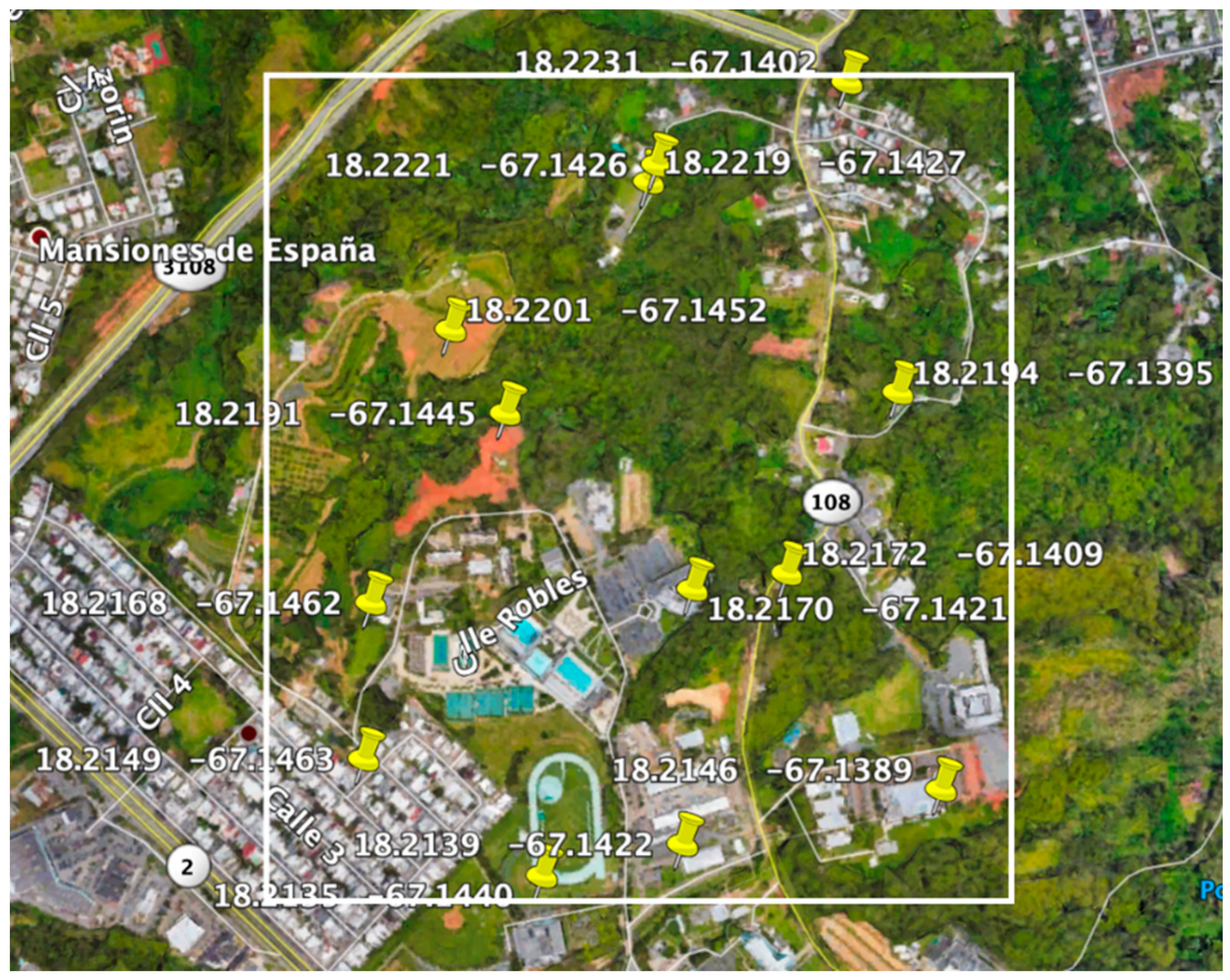
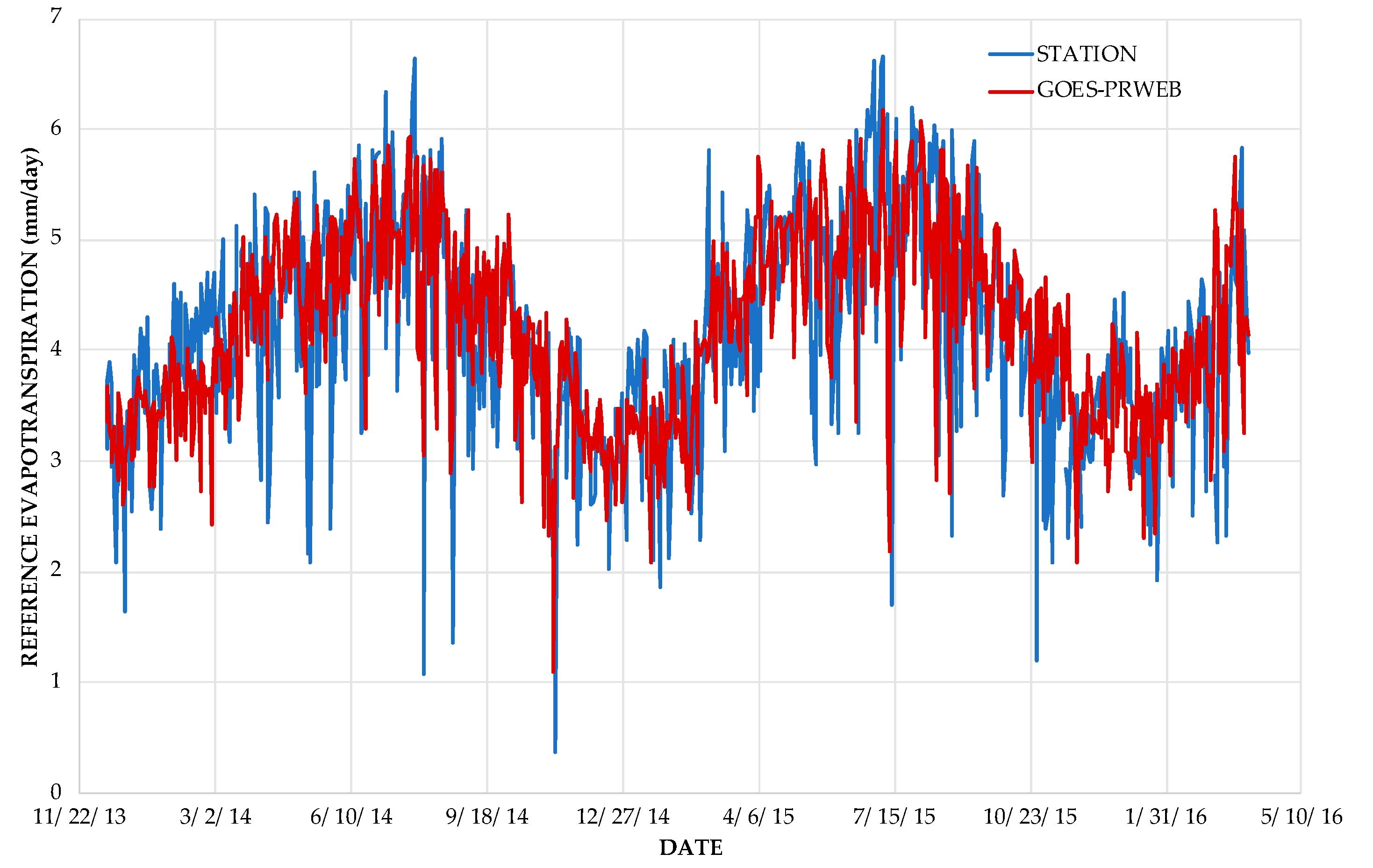
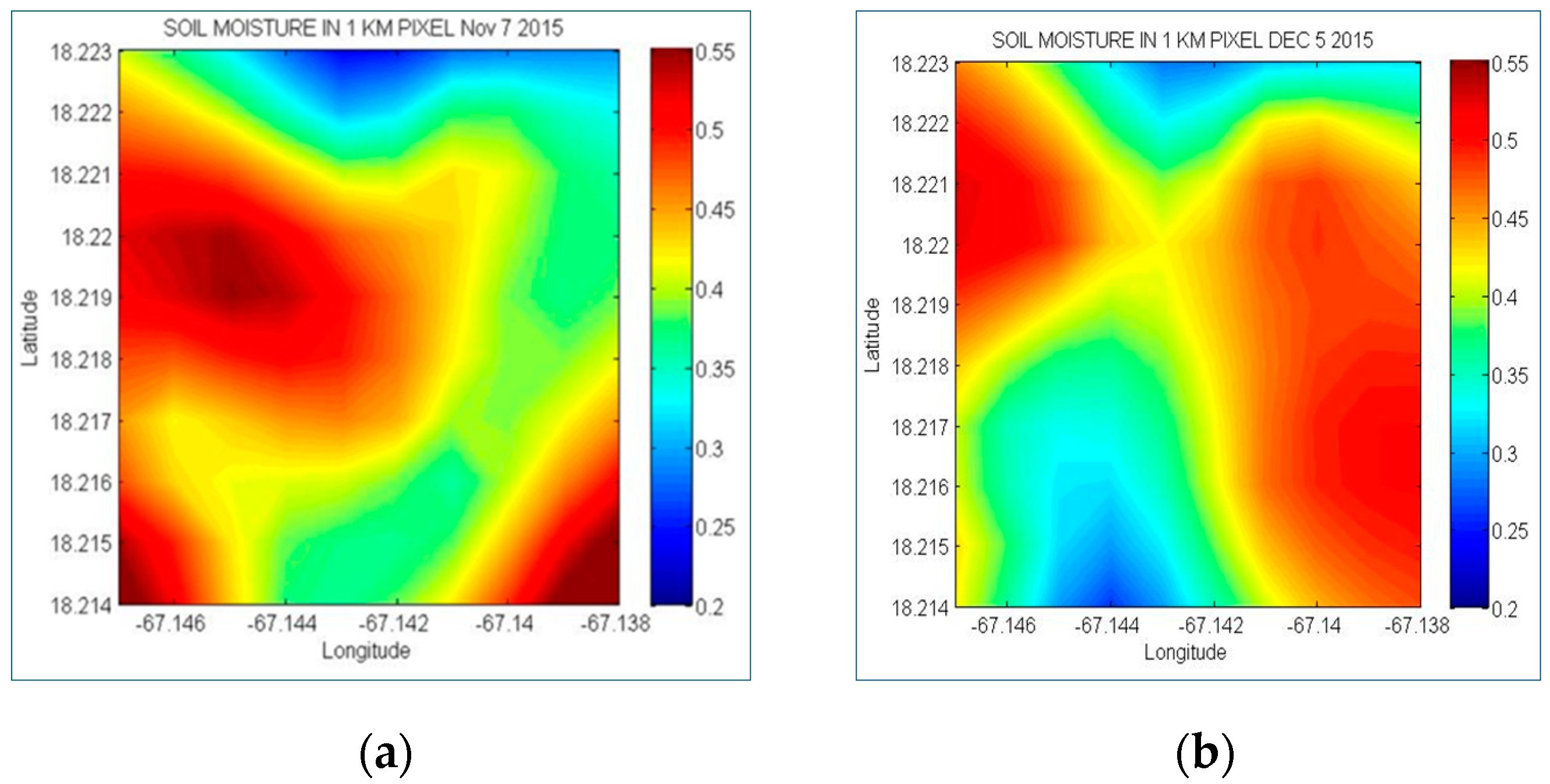

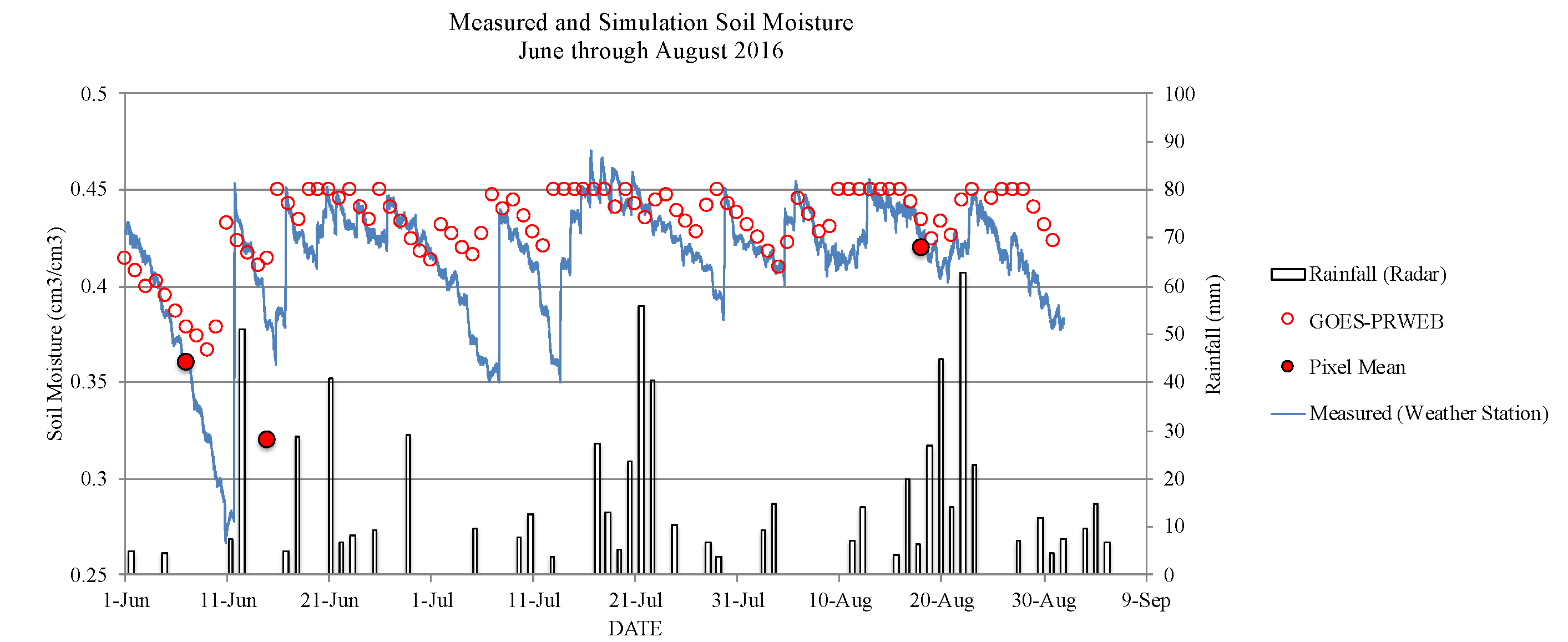
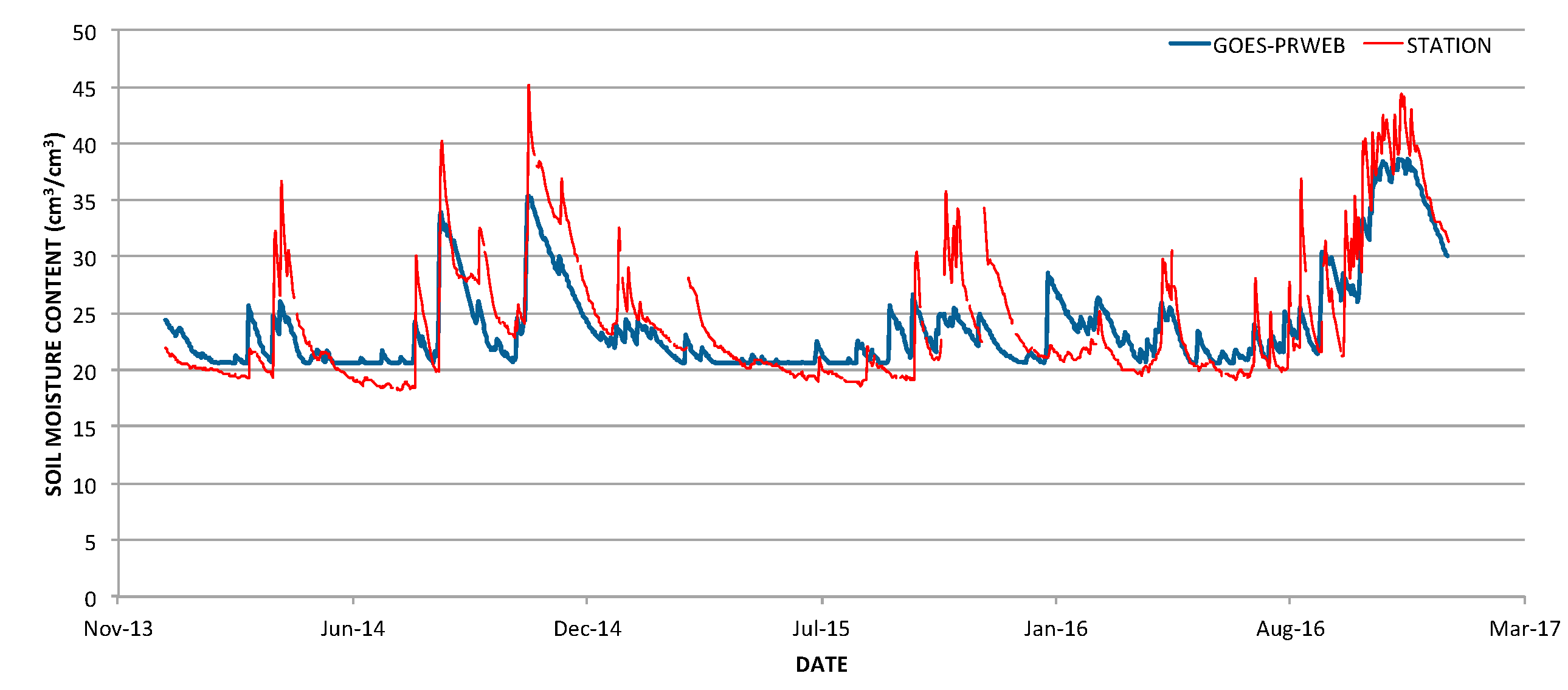
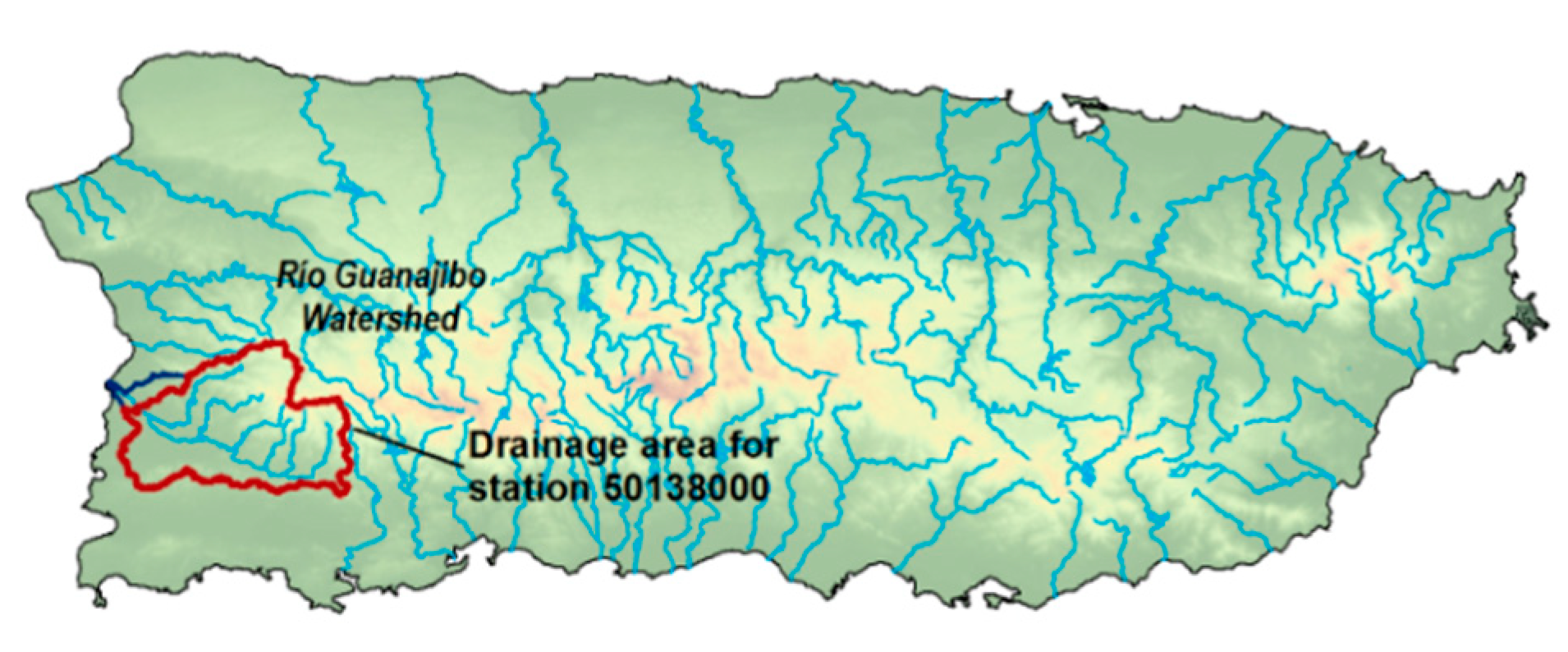
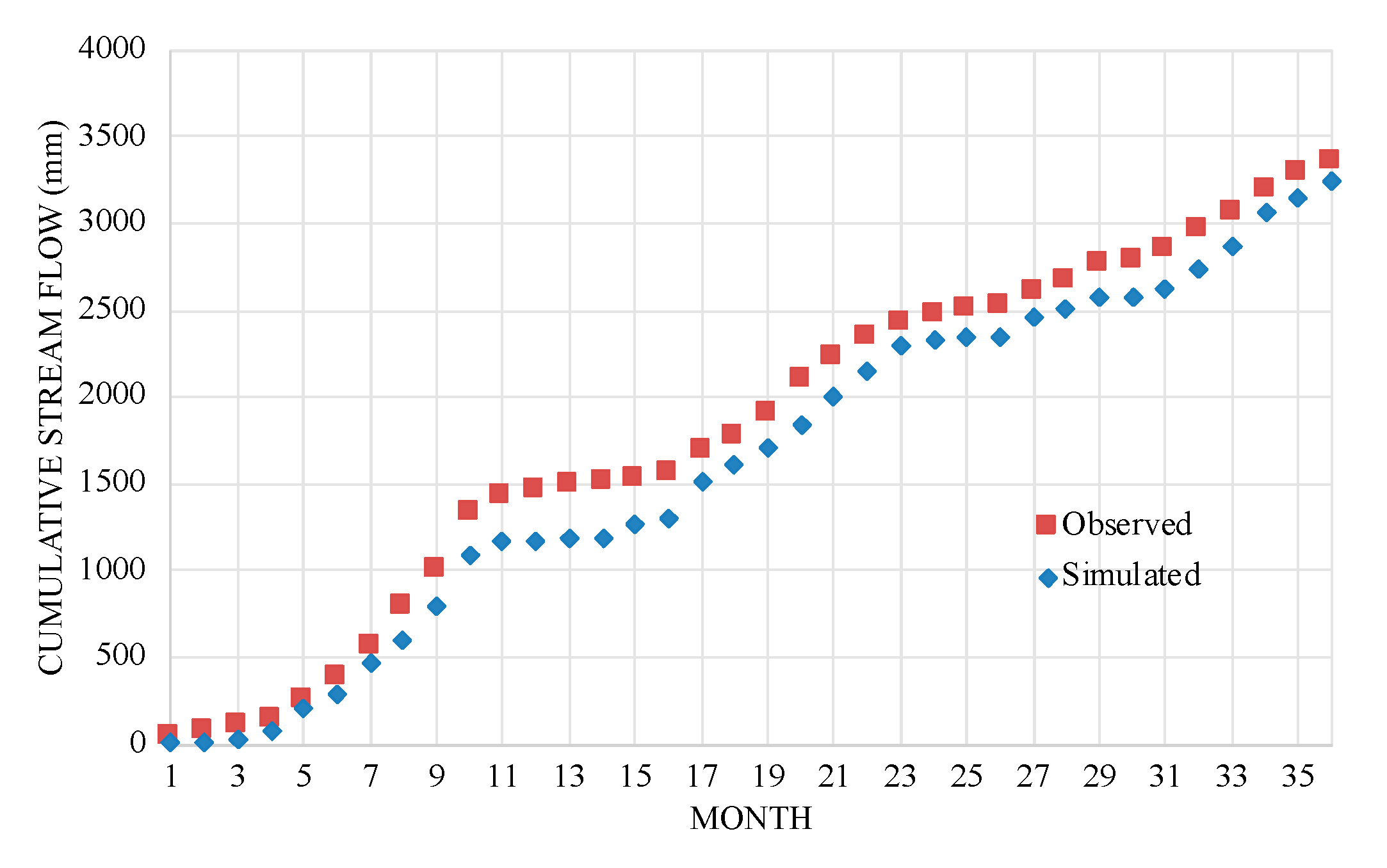

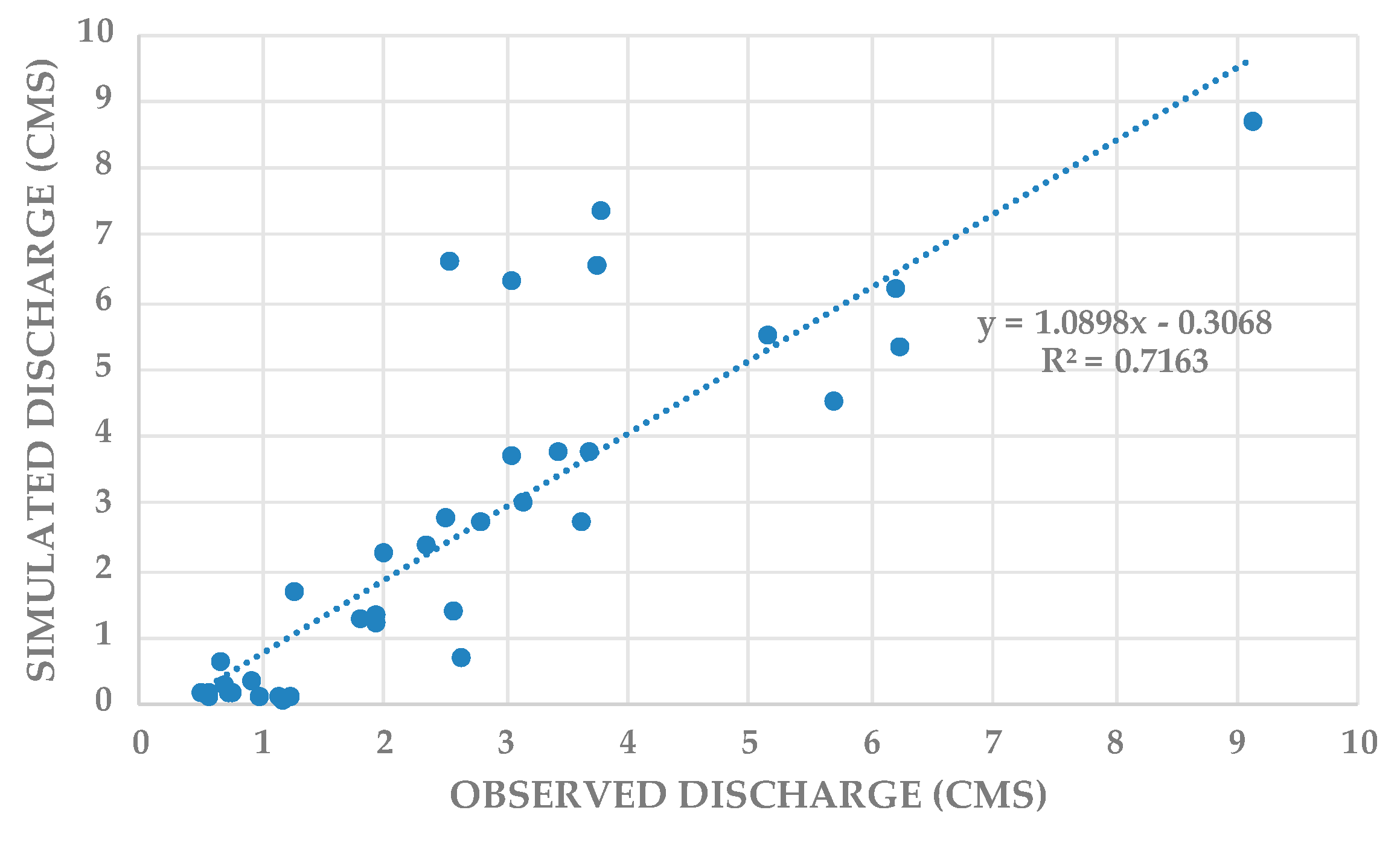
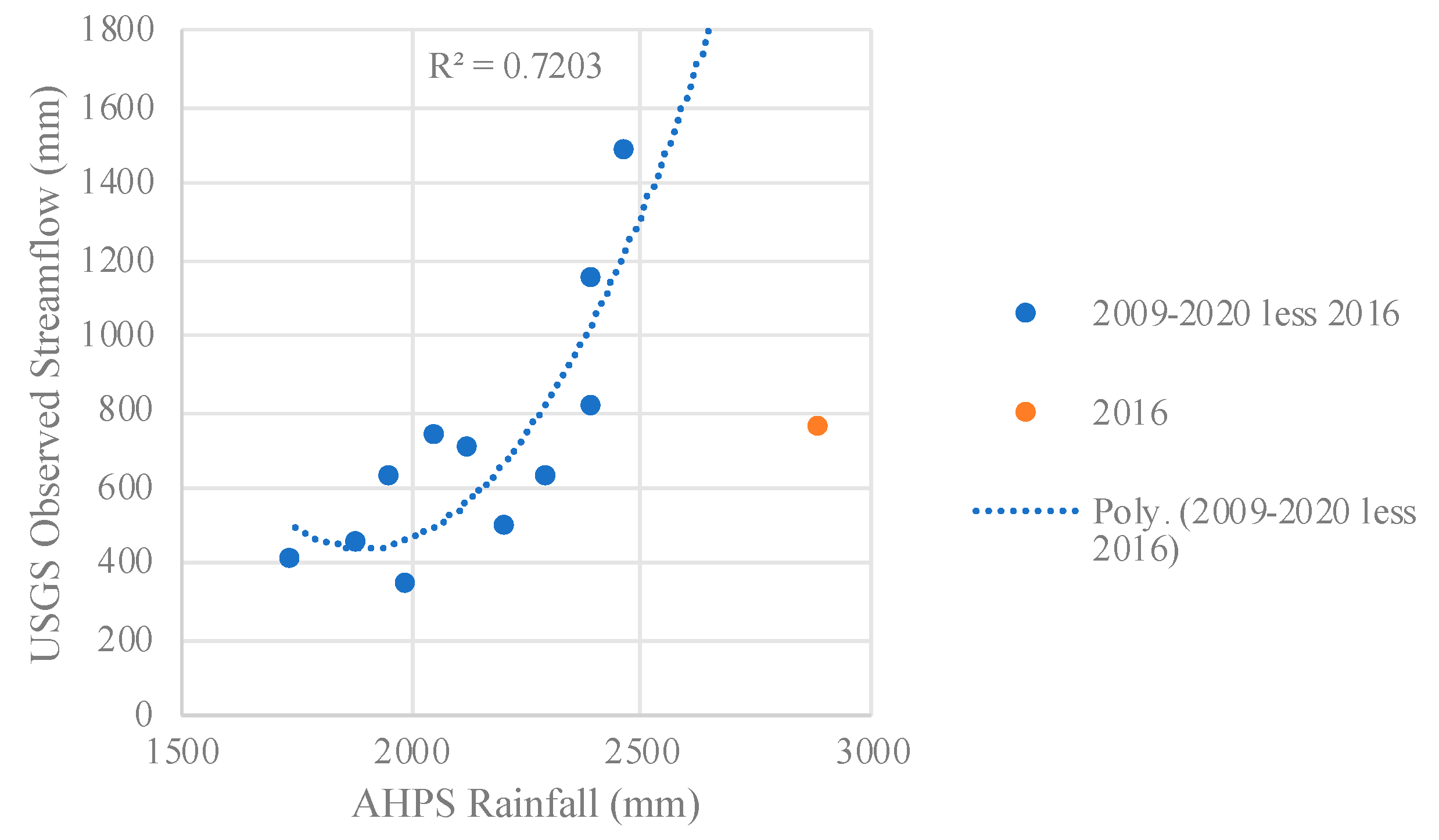
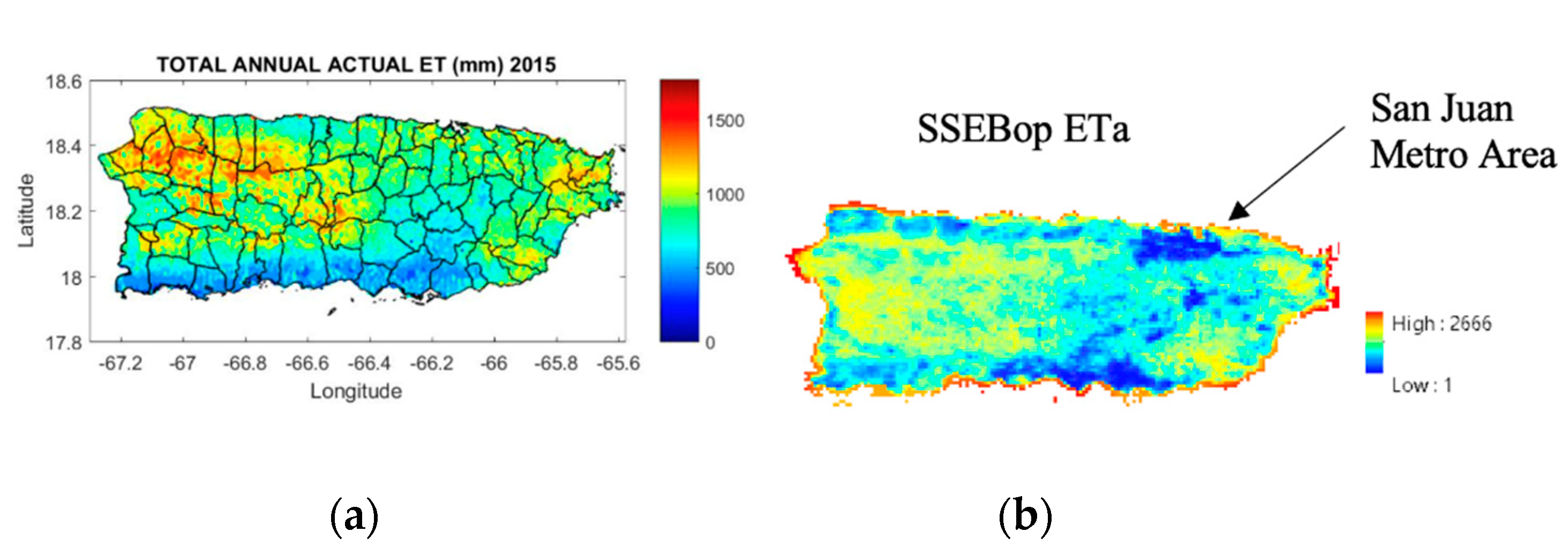
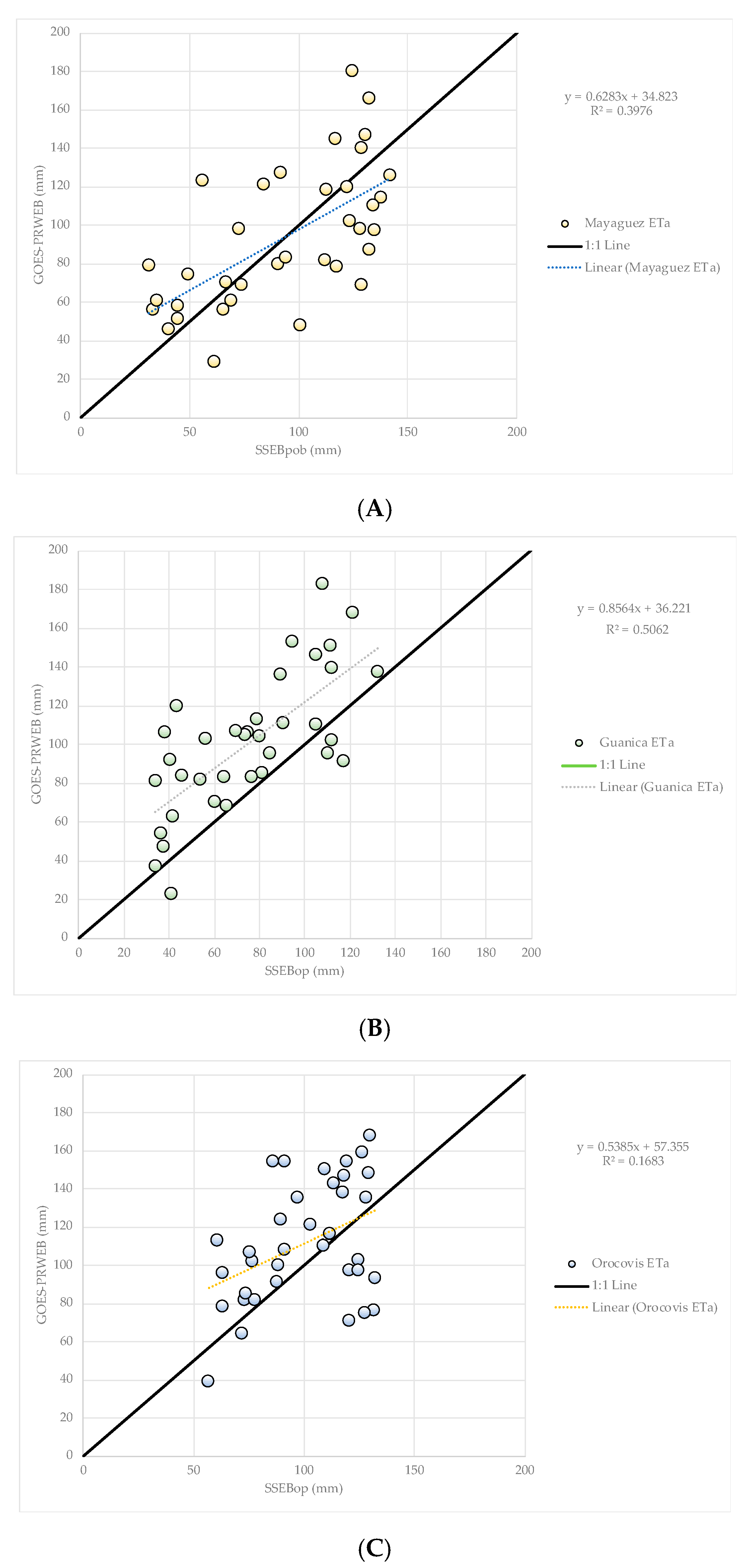
| GOES-PRWEB Average | Station Average | Average % Error | Significant Difference | |
|---|---|---|---|---|
| ETo (mm day−1) | 4.22 | 4.18 | 0.96 | No |
| Tmin (°C) | 23.16 | 22.37 | 3.51 | Yes |
| Tmax (°C) | 31.15 | 31.24 | −0.14 | No |
| Td (°C) | 21.24 | 23.27 | −8.72 | Yes |
| u2 (m s−1) | 1.69 | 2.08 | −18.85 | Yes |
| Rs (MJ m−2 day−1) | 18.94 | 21.03 | −9.93 | No |
| Year | AHPS Rainfall (mm) | USGS Stream-Flow (mm) | USGS ETa (mm) | GOES-PRWEB ETa (mm) | Error (%) |
|---|---|---|---|---|---|
| 2009 | 2130 | 703 | 1335 | 1317 | −1.35 |
| 2010 | 2398 | 1144 | 1151 | 1311 | 13.90 |
| 2011 | 2396 | 808 | 1485 | 1276 | −14.07 |
| 2012 | 2301 | 621 | 1540 | 1337 | −13.18 |
| 2013 | 1890 | 445 | 1357 | 1259 | −7.22 |
| 2014 | 1997 | 343 | 1577 | 1278 | −18.96 |
| 2015 | 1746 | 400 | 1271 | 1226 | −3.54 |
| 2016 | 2886 | 757 | 2129 | 1304 | −38.75 |
| 2017 | 2473 | 1483 | 990 | 1060 | 7.07 |
| 2018 | 2205 | 487.9 | 1717 | 1369 | −20.27 |
| 2019 | 1961 | 621 | 1340 | 1277 | −4.70 |
| 2020 | 2054 | 732 | 1322 | 1350 | 2.12 |
| Average | 1371 | 1278 | −6.80 |
| Year | AHPS Rainfall (mm) | SSEBop ETa (mm) | GOES-PRWEB ETa (mm) | Error (%) |
|---|---|---|---|---|
| 2009 | 2130 | 1204 | 1223 | 1.58 |
| 2010 | 2398 | 1244 | 1250 | 0.48 |
| 2011 | 2396 | 1232 | 1247 | 1.22 |
| 2012 | 2301 | 1229 | 1250 | 1.71 |
| 2013 | 1890 | 1193 | 1190 | −0.25 |
| 2014 | 1997 | 1137 | 1182 | 3.96 |
| 2015 | 1746 | 1116 | 999 | −10.48 |
| 2017 | 2473 | 1178 | 1201 | 1.95 |
| 2018 | 2205 | 1155 | 1045 | −9.52 |
| 2019 | 1961 | 1182 | 1167 | −1.27 |
| 2020 | 2054 | 1109 | 1130 | 1.89 |
| Average | 2141 | 1180 | 1171 | −0.73 |
| Site | Lon | Lat | Elevation (m) | Land Cover | Climate |
|---|---|---|---|---|---|
| Mayagüez | 18.22 | −67.146 | 36 | Urban and Built up | Humid |
| Guánica | 17.95 | −66.940 | 30 | Woodlands | Semi Arid |
| Orocovis | 18.20 | −66.470 | 985 | Deciduous Forest | Humid |
| Year | Rainfall (mm) | ETa (mm) | RO + DP * (mm) | Runoff (mm) | Deep Percolation (mm) | Balance: Rainfall − ETa − (RO + DP) (mm) |
|---|---|---|---|---|---|---|
| GOES-PRWEB | ||||||
| 2009 | 1631 | 1223 | 446 | 360 | 86 | −38 |
| 2010 | 2204 | 1250 | 967 | 741 | 227 | −14 |
| 2011 | 2246 | 1247 | 1020 | 790 | 230 | −21 |
| 2012 | 1837 | 1250 | 614 | 498 | 116 | −27 |
| 2013 | 1830 | 1190 | 637 | 483 | 154 | 3 |
| 2014 | 1611 | 1182 | 500 | 417 | 83 | −71 |
| 2015 | 1415 | 999 | 407 | 335 | 73 | 8 |
| 2016 | 2140 | 1201 | 925 | 677 | 248 | 14 |
| 2017 | 2653 | 1045 | 1644 | 1122 | 523 | −37 |
| 2018 | 1729 | 1167 | 622 | 447 | 181 | −66 |
| 2019 | 1584 | 1130 | 407 | 343 | 64 | 47 |
| 2020 | 1785 | 1234 | 551 | 427 | 124 | 0 |
| Standard Deviation | 353.9 | 81.5 | 359.5 | 236.1 | 127.1 | 33.9 |
| Average | 1888.8 | 1176.5 | 728.3 | 553.3 | 175.8 | −16.8 |
| Percent of Rainfall | 100.0% | 62.3% | 38.6% | 29.3% | 9.3% | −0.9% |
| USGS [62] | ||||||
| Average | 1829.0 | 1168.0 | 635.0 | 27.0 | ||
| Percent of Rainfall | 100.0% | 63.9% | 34.7% | 1.5% | ||
| Mean Error (mm) | Minimum Error (mm) | Maximum Error (mm) | |
|---|---|---|---|
| Mayagüez | |||
| Mean (2009–2020) | 0.01 | −1.5 | 20.78 |
| Std. Dev. | 0.07 | 0.93 | 8.33 |
| Guánica | |||
| Mean (2009–2020) | 0.05 | −1.38 | 21.6 |
| Std. Dev. | 0.04 | 0.98 | 8.49 |
| Orocovis | |||
| Mean (2009–2020) | 0.04 | −0.73 | 16.49 |
| Std. Dev. | 0.03 | 1.28 | 8.04 |
| 1 | 2 | 3 | 4 | 5 | 6 |
|---|---|---|---|---|---|
| Year | θJan 1 | θDec 31 | θJan 1 − θDec 31 | Rainfall − ETa − RO+DP (% of Rainfall) | Water Balance Error (col 5 − col 4, % of Rainfall) |
| 2009 | 30.9% | 30.0% | −0.9% | −2.3% | −1.4% |
| 2010 | 29.9% | 28.5% | −1.4% | −0.6% | 0.8% |
| 2011 | 28.7% | 27.9% | −0.7% | −0.9% | 0.2% |
| 2012 | 29.9% | 30.9% | 1.0% | −1.5% | −2.5% |
| 2013 | 30.7% | 30.2% | −0.4% | 0.2% | 0.6% |
| 2014 | 30.3% | 26.7% | −3.5% | −4.4% | 0.9% |
| 2015 | 26.3% | 27.4% | 1.1% | 0.6% | −0.5% |
| 2016 | 27.2% | 31.4% | 4.2% | 0.7% | −3.5% |
| 2017 | 32.3% | 28.8% | −3.5% | −1.4% | 2.1% |
| 2018 | 28.8% | 26.3% | −2.5% | −3.8% | −1.3% |
| 2019 | 26.2% | 29.8% | 3.6% | 3.0% | −0.6% |
| 2020 | 29.9% | 29.8% | −0.1% | 0.0% | 0.1% |
| Average | 29.2% | 29.0% | −0.2% | −0.9% | −0.7% |
Publisher’s Note: MDPI stays neutral with regard to jurisdictional claims in published maps and institutional affiliations. |
© 2021 by the authors. Licensee MDPI, Basel, Switzerland. This article is an open access article distributed under the terms and conditions of the Creative Commons Attribution (CC BY) license (https://creativecommons.org/licenses/by/4.0/).
Share and Cite
Harmsen, E.W.; Mecikalski, J.R.; Reventos, V.J.; Álvarez Pérez, E.; Uwakweh, S.S.; Adorno García, C. Water and Energy Balance Model GOES-PRWEB: Development and Validation. Hydrology 2021, 8, 113. https://doi.org/10.3390/hydrology8030113
Harmsen EW, Mecikalski JR, Reventos VJ, Álvarez Pérez E, Uwakweh SS, Adorno García C. Water and Energy Balance Model GOES-PRWEB: Development and Validation. Hydrology. 2021; 8(3):113. https://doi.org/10.3390/hydrology8030113
Chicago/Turabian StyleHarmsen, Eric W., John R. Mecikalski, Victor J. Reventos, Estefanía Álvarez Pérez, Sopuruchi S. Uwakweh, and Christie Adorno García. 2021. "Water and Energy Balance Model GOES-PRWEB: Development and Validation" Hydrology 8, no. 3: 113. https://doi.org/10.3390/hydrology8030113
APA StyleHarmsen, E. W., Mecikalski, J. R., Reventos, V. J., Álvarez Pérez, E., Uwakweh, S. S., & Adorno García, C. (2021). Water and Energy Balance Model GOES-PRWEB: Development and Validation. Hydrology, 8(3), 113. https://doi.org/10.3390/hydrology8030113







